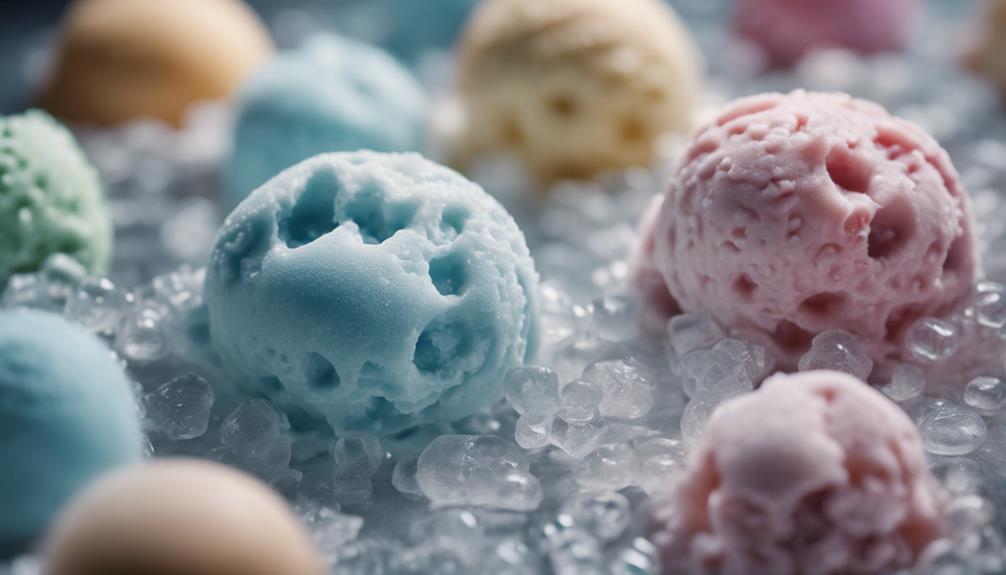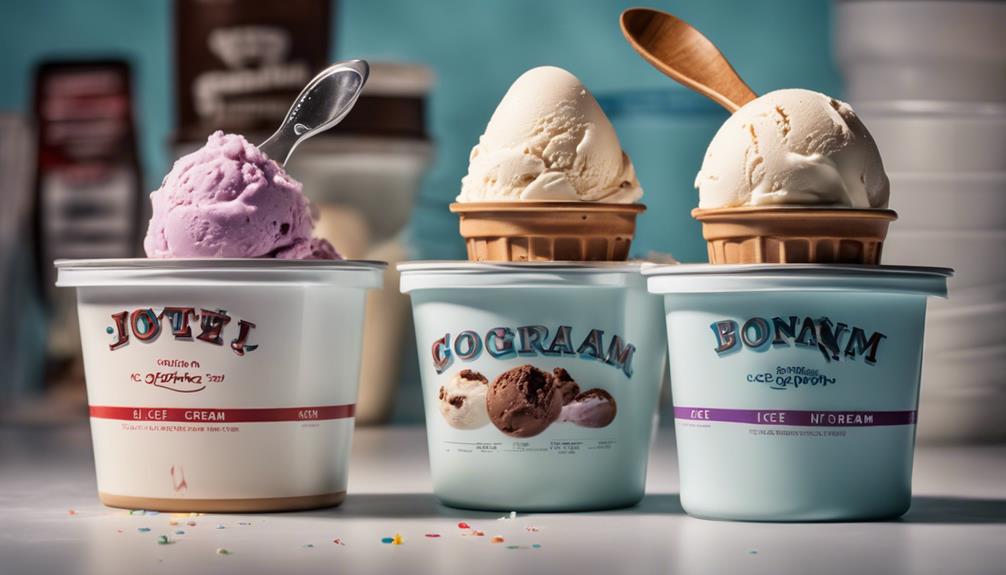You enjoy ice cream because of its magical chemistry! Emulsifiers and stabilizers work together to create its creamy texture. Fat, water, sugar, and air come together perfectly. Lecithin assists in blending fats smoothly, while stabilizers prevent icy crystals. Churning and freezing trap air, making it light and fluffy. The fat content is crucial, with premium varieties containing up to 20% fat. Different types such as soft-serve and frozen custard offer unique textures. Therefore, the next time you indulge in a cone, keep in mind the intricate science behind the scoop that makes it so irresistible!
Key Takeaways
- Perfect balance of fat, sugar, and air creates creamy texture and flavor.
- Emulsifiers and stabilizers prevent crystal formation for a smooth consistency.
- Cold temperature triggers brain freeze, a temporary but intense sensation.
- Variety in types like soft-serve, frozen custard, and frozen yogurt cater to different preferences.
- Science behind fat content, air incorporation, and stabilizers enhances ice cream's appeal.
The Chemistry of Ice Cream

Explore the fascinating chemistry behind ice cream, where emulsifiers and stabilizers play vital roles in creating its creamy texture. Ice cream is a scientific marvel, with its combination of fat globules, water, sugar, and air bubbles resulting in a delightful treat. The science behind ice cream lies in its composition, where emulsifiers like lecithin assist fat globules in coming together while preventing them from clumping. Stabilizers are also essential, as they prevent large crystal formation and absorb excess liquid, ensuring a smooth texture.
The chemistry of ice cream involves the delicate balance of ingredients that don't naturally mix. Emulsifiers help bind the fat globules with water and sugar, creating a homogenous mixture. This mixture is then churned and frozen, incorporating air bubbles to give ice cream its signature foam-like texture.
The role of science in ice cream production is evident in how emulsifiers and stabilizers work together to create a delectable dessert that's enjoyed by many.
Ice Cream Composition Insights

Understanding the components that make up ice cream provides valuable insights into its composition and overall quality. The fat content in ice cream is a pivotal factor, as it not only contributes to the creamy texture but also impacts the flavors it offers. Ice cream must contain a minimum of 10% fat, with premium varieties containing up to 20% fat for a richer taste. Milk fat, a primary source of fat in ice cream, plays a significant role in determining its texture.
Additionally, the amount of air introduced during the churning process, known as overrun, influences the final product's density and mouthfeel. Stabilizers in ice cream help prevent the formation of large ice crystals and aid in absorbing liquid content, contributing to a smoother texture.
Effects of Air and Stabilizers

The incorporation of air and stabilizers in ice cream production greatly influences its texture and consistency. Air is introduced during the churning process, creating what's known as overrun, which affects the density and texture of the final product.
Ice cream is an emulsion where air bubbles are dispersed throughout, giving it a foam-like structure. Stabilizers play a pivotal role in maintaining a smooth consistency by preventing large crystal formation and absorbing excess liquid.
Without stabilizers, ice cream could become icy or develop undesirable ice crystals, resulting in a less creamy texture. The amount of air incorporated also impacts the density of the ice cream; more air leads to a lighter product.
Brain Freeze Phenomenon

When indulging in cold treats like ice cream, you may have experienced the sudden jolt of discomfort known as brain freeze. This phenomenon occurs when cold ice cream touches the roof of your mouth, causing blood vessels in your head to dilate. As a result, the nerve center overreacts to the cold sensation, leading to a headache.
The brain then responds by attempting to heat up quickly in response to the extreme cold, creating the familiar brain freeze sensation. This temporary and harmless experience typically lasts for just a few seconds.
- Brain freeze is triggered by the cold temperature affecting the blood vessels and nerve response.
- The sudden dilation of blood vessels in the head leads to a headache.
- The nerve center overreacts to the cold sensation, causing discomfort.
- The brain's attempt to rapidly heat up results in the temporary brain freeze sensation.
Types of Ice Cream Varieties

Soft-serve ice cream is a popular variety known for its higher serving temperature and softer texture compared to traditional ice cream.
Frozen custard, on the other hand, includes at least 1.4% egg yolks, resulting in a smoother and denser consistency.
If you're looking for a healthier option, frozen yogurt is a go-to with less fat but typically higher sugar content than traditional ice cream.
The density of ice cream can vary based on the amount of air incorporated during production, influencing its texture and mouthfeel.
Each type of ice cream, whether it's soft-serve, frozen custard, or frozen yogurt, brings unique ingredients and textures to suit diverse preferences.
Whether you prefer the light fluffiness of soft-serve, the richness of frozen custard, or the tangy sweetness of frozen yogurt, there's a type of ice cream out there to satisfy your cravings.
Factors Influencing Ice Cream Addiction

When it comes to ice cream addiction, your craving for sweet flavors plays a significant role in drawing you towards that irresistible scoop.
The sensory experience, from appearance to texture, also influences your love for this frozen treat.
Understanding how these factors impact your addiction to ice cream can help you appreciate its allure even more.
Craving Sweet Flavors
The irresistible allure of sweet flavors is a primary factor driving the addictive nature of ice cream consumption.
When it comes to ice cream, the perfect balance of sweetness, texture, and temperature creates an irresistible treat that keeps you coming back for more.
The sugary flavors present in ice cream tap into our cravings for something sweet, triggering a sense of satisfaction that can be hard to resist.
Additionally, the interplay between fat content and flavor profile enhances the addictive quality of this frozen delight, making it a go-to treat for many.
In addition, memories associated with specific flavors can further intensify the longing for a scoop of ice cream, adding a personal touch to the already addictive experience.
Sensory Experience Impact
Enhancing the sensory experience of ice cream involves a delicate interplay of various factors that contribute to its addictive appeal. The flavor profile, texture, temperature, aroma, acidity, and control over melt all work together to create a truly satisfying treat. Balancing sweetness and fat content is essential in achieving that perfect mouthfeel that keeps you coming back for more.
To better understand the impact of these factors, let's break them down in the table below:
| Factors | Influence on Ice Cream Addiction |
|---|---|
| Flavor Profile | Determines the overall taste experience |
| Texture | Affects the feel of the ice cream in your mouth |
| Temperature | Influences how flavors unfold on the palate |
| Aroma | Enhances the sensory appeal of the ice cream |
| Control over Melt | Impacts the overall enjoyment of the treat |
Frequently Asked Questions
What Is the Science Behind Why We Love Ice Cream?
You love ice cream because it triggers endorphins, satisfies cravings, offers rich textures, and evokes nostalgia. The combination of sweetness, fats, and variety of flavors enhances the sensory experience. Science in production elevates flavor.
Is It Scientifically Proven That Ice Cream Makes You Happy?
Indulging in ice cream triggers endorphins, boosting mood and creating happiness. The pleasure center in your brain lights up, leading to joy and satisfaction. So, go ahead, grab a scoop and savor the bliss!
Why Is Ice Cream so Special?
Ice cream is special for its creamy texture, sweet taste, and diverse flavors that cater to every palate. The delightful combination of fats, sugars, water, and flavorings creates a unique sensory experience that brings joy.
Why Is Ice Cream so Addictive?
Ice cream is addictive due to its perfect mix of sweetness, fat, and texture that your brain craves. Regular consumption can lead to increased desire. Memories also play a role. Enjoy it in moderation to manage cravings and guilt.
What Makes Unusual Ice Cream Flavors Irresistible Despite Their Surprising Ingredients?
It’s true that shocking ice cream flavors exist, but that’s part of their appeal. People are drawn to the unexpected and the unconventional, and that’s exactly what unusual ice cream flavors offer. Despite their surprising ingredients, these flavors are irresistible because they provide a unique and memorable culinary experience.
Conclusion
So next time you find yourself indulging in a creamy, dreamy scoop of ice cream, remember the magical chemistry at play that makes it so irresistibly good.
From the perfect balance of ingredients to the satisfying brain freeze sensation, ice cream is a delectable treat that tantalizes your taste buds like no other.
Embrace the delicious addiction and savor every spoonful of this frozen delight!
















